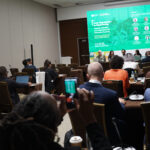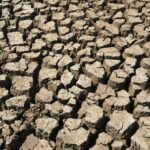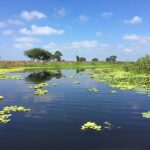Whispers from the marsh, how to save wetlands

Photo Credit: Hanifi Koç, 2/6th Greenstorm Photo Festival, UNCCD-G20 GLI
The word “wetlands” often conjures up images of quiet waters, half–submerged trees and reed-filled shores.. Yet this picture captures only a small part of a much broader landscape.
Imagine instead, vast cascading rice paddies carved into a hillside, shimmering like emerald steps under the morning sun — these too are wetlands, integral to the livelihoods of millions.
Wetlands take many forms: from freshwater marshes and mangroves to peatlands, tidal flats, lakes, coral reefs, and man-made rice fields. They cover only around 6% of the Earth’s surface and deliver an estimated USD$7.98 to USD$39.01 trillion United States dollars in ecosystem services every year.
This value, which is immense, stems from their vital, but often overlooked, functions. As a result, wetlands continue to vanish at a disconcerting rate. The extent of this loss especially when set against the benefits received, underscores a critical and urgent need for global action.
Wetlands equal to half a billion football fields lost since 1970
According to the Global Wetland Outlook 2025 (GWO 2025) released a week ago, wetlands are disappearing at a rate of 0.52% annually, with an estimated 22% lost since 1970—an area larger than India, or roughly half a billion football fields.
While the magnitude of the current wetlands decline is deeply concerning, the condition of existing wetlands is equally, if not more, alarming. Nearly one in four remaining wetlands is in poor ecological health, with widespread degradation reported across all regions. There is a need to protect to what is remaining.
These are some of the challenges that the Parties to the Convention on Wetlands are expected to discuss during their fifteenth meeting, which is taking place from 23 to 31 July 2025 in Victoria Falls, Zimbabwe.
What makes wetlands valuable?
Wetlands play an indispensable role in sustaining ecosystems, economies and communities. They purify water by filtering pollutants, recharge aquifers, and provide the clean water on which all life depends. This clean water then supports a vibrant web of life: birds, animals, and aquatic species that thrive in wetland estuaries.
In the United States alone, coastal wetlands sustain a prawn industry worth over USD$500 million annually, linking ecological health directly to local economies.
Beyond biodiversity, wetlands also contribute to food security. Rice paddies, a type of man-made wetlands, feed more than half of the world’s population.
These ecosystems also act as natural buffers. Mangroves and marshes absorb the force of storm surges and floods, protecting vulnerable coastal communities. Inland, peatlands act as major carbon sinks, quietly storing greenhouse gases and playing a critical role in climate mitigation.
Why choose conservation over restoration?
Now that the need to protect wetlands is widely recognised, the path forward requires more than momentum, it calls for intention, foresight and care.
One of the most compelling findings from the GWO 2025 is this: restoration is neither simple nor inexpensive. Data drawn from global case studies show that the cost of restoring wetlands ranges from USD$1,000 to over USD$70,000 per hectare, depending on the type of ecosystem and its condition.
What’s cheaper is conserving existing wetlands. It is both significantly more affordable and more effective. Prioritising protection over restoration is not only a practical decision, but an economic one.
The estimated global financing required to achieve wetland conservation and restoration targets are USD$275-550 billion per year, a figure far exceeding current investment levels.
Currently, biodiversity conservation across all ecosystems accounts for only 0.25% of global Gross Domestic Product. This signals a substantial underinvestment in wetlands despite their strategic importance to biodiversity, climate, water and disaster resilience agendas.
When wetland ecosystems are cleared for development or drained for short-term gains, the long-term costs come back many times over. For example, in the form of climate-related disasters, economic disruption or human displacement. Embedding wetlands into national development strategies is no longer optional. It’s essential.
Practical Policy Pathways Forward
While we understand the values and economic importance of wetlands, this knowledge needs to be translate into coherent action through policies, planned frameworks and financial systems that reflect the actual worth of these ecosystems.
The Global Wetland Outlook 2025 proposes the way forward through integrated approaches that prioritise conservation, mobilize investment and embed wetlands at the heart of sustainable development.
The report also underscores the need to break out of the sectoral silos. Wetlands are seen as isolated environmental concerns, but in reality they sit at the intersection of water management, agriculture, energy systems and infrastructure planning. Integrating them into national water strategies, land-use policies and infrastructure development ensures they are not sacrificed in pursuit of short-term gains.
It also stress the need to recognise wetlands as shared public assets. But this requires strong institutional alignment especially across sectors like agriculture, water, energy and urban development, where decisions often directly impact wetland health.
Alongside institutional reform, the Report recommends strengthening how wetlands are valued in economic and environmental planning. It argues that when wetlands are more likely to be protected when their benefits are visible in budgets and investment frameworks.
Some examples of the natural capital accounting tools that allow countries to measure the true contribution of wetlands to national well-being are the UN’s System of Environmental-Economic Accounting (SEEA) or the Toolkit for Ecosystem Service Site – based Assessment (TESSA).
Financing for wetlands is another often overlooked policy area.
Wetlands receive a fraction of the funding they need despite their vital role in delivering on the Sustainable Development Goals and the Paris Agreement.
This gap can be addressed through innovative financial instruments such as blue bonds, biodiversity credits and payment for ecosystem services (PES). Public–private partnerships, backed by smart regulation and risk guarantees, can help scale these approaches while ensuring transparency and equity.
Wetland conservation can also be financed through policy tools that embed environmental accountability into development decisions, an approach that is gaining momentum.
There is also the biodiversity net gain frameworks – already adopted in some countries. It requires developers to deliver measurable ecological benefits.
Wetland-specific offset mechanisms, including mitigation banking, offer another pathway to fund restoration and conservation efforts if they are backed by rigorous standards and governance.
Wetlands are not peripheral ecosystems. They are foundational to climate action, food and water security, and disaster resilience. The crisis they face is silent, but the solutions are clear. Conservation is the most cost-effective and impactful path forward but it requires institutional courage, financial innovation and a willingness to see wetlands not as wastelands, but as lifelines.
Download the Global Wetland Outlook 2025




